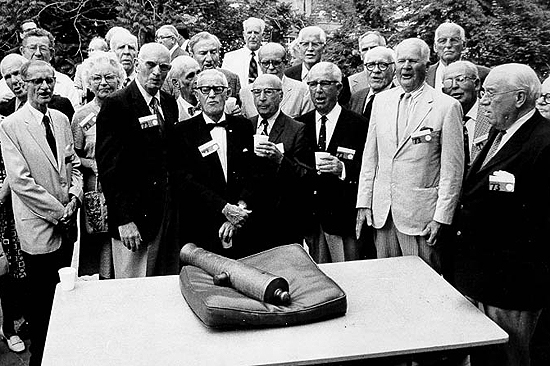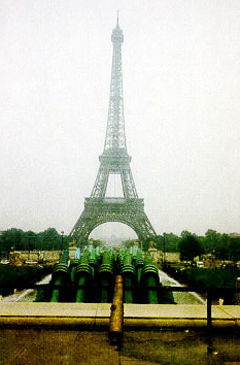Wesleyan’s Douglas Cannon to Return after 10 Years?
 |
| Members of the class of 1918, the last class to hold a “Cannon Scrap” on campus, serenade the Douglas Cannon at their 55th reunion in 1973. Rumors have it that the cannon may return this year during Reunion & Commencement Weekend. Below, the cannon makes an appearance in Paris, France in the mid 1980s. |
| Posted 04/02/07 |
 There are no promises, but rumors have been heard that the 139-year-old Douglas Cannon a revered Wesleyan artifact may make an appearance during the 175th Commencement this May. There are no promises, but rumors have been heard that the 139-year-old Douglas Cannon a revered Wesleyan artifact may make an appearance during the 175th Commencement this May.
John Driscoll, director of alumni relations, says he’s heard vague rumblings that the cannon might be leaving a current sanctuary and be heading towards Connecticut. “I know I looked carefully throughout Southeast Asia and it wasn’t there, Driscoll says. But I daresay there is more than just rumor floating in the air. I would be exceedingly presumptuous to predict with confidence, but I hear there are noises, promising ripples not heard for too long. Like the promise of spring, they instill hope. The Douglas Cannon, a 140-pound, 29-inch long, brass artillery instrument, has been a celebrated saga on campus since the 1860s. A yearly contest, the “Cannon Scrap,” developed between the freshmen, whose mission it was to fire the cannon on Feb. 22, and the sophomores, who were charged with foiling the effort. The game ended in 1916 and in 1931, the cannon was filled with 100 pounds of lead and mounted to a block of brownstone between Memorial Chapel and South College. The cannon remained there for 26 years, only to be stolen by students in 1957, returned, then stolen again in 1959. The cannon has traveled widely since that time: it has been hidden in dormitories, presented to the Russian Mission at the United Nations as a “symbol of peace, brotherhood, and friendship,” appeared unexpectedly in the offices of the managing editor of Life magazine, presented to President Richard M. Nixon as a protest against the war in Vietnam, and baked into Wesleyan’s sesquicentennial birthday cake in 1981. In 1982, the gun went missing once more. Using bolt cutters, wire cutters, pliers, vice grips, a crow bar, sheet metal hammer and a hook and wood saw, cannon-nappers broke into the Office of Public Safety, where the cannon was residing. They left $5 to pay for their damages. The thieves known as Doug Addicts took the cannon on a world tour, making stops in London and Paris, as revealed in photographs. A postcard from “Doug” arrived in the president’s office from Venezuela in 1989. Customs stamps on the cannon’s wooden crate, noticed at a later appearance, confirmed that it left the country. Its been 10 years since the cannon appeared on campus. In 1997, the cannon was gifted in a large plaster package with a red ribbon near the Davenport Campus Center. The plaster was broken apart with hammers and chisels and the wooden crate inside containing the cannon was swiftly carried off by a group of students. Bill Burkhart, university photographer, has witnessed the cannons disappearing acts for 17 years. The Douglas Cannon tradition is becoming a non-tradition, since five classes have graduated, clueless to the cannons significance, Burkhart says. Come home Doug, come home. Soon. Driscoll says he and Suzy Taraba, university archivist, received photos showing the cannon well cared for by scantily clad revelers during Homecoming/Family Weekend three years ago. Two years ago, a cannon appeared at halftime during the homecoming football game, however, it was suspected of being a fraud. So, I think it is fair to say, subject to counter claims and evidence, that there has not been a full-blown appearance of the Cannon since 1997, Driscoll says. Driscoll says the 175th commencement would be a good time for the cannon to make an appearance. It certainly would be a good time, what with length of absence and too many Wesleyan folks knowing too little about this fun-filled tradition, and it being our 175th year, and, finally, it being the end of the Bennets’ good tenure –the name Douglas should mean something — but it is too early to tell, he says. For more on the history of the Douglas Cannon, go to: http://www.wesleyan.edu/libr/schome/cannon/cannon.htm. |
| By Olivia Drake, The Wesleyan Connection editor |

